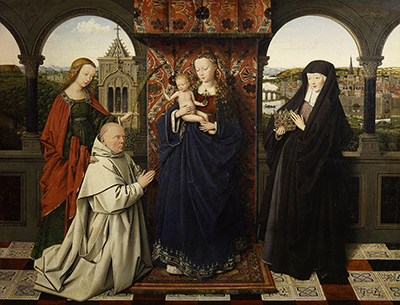This highly intricate painting perfectly captures some of the key attributes for which we remember the old master Jan van Eyck. Those interested in seeing this piece in person should head to the Frick Collection in New York, USA.
As is the case for many of this artist's best work, one can keep returning again and again, each time spotting something new in the detailed and subtly delivered setting. It takes us back in time because of the way in which van Eyck produced work in such a realistic manner that was new for that period. He would take elements of Gothic art and combine it with some of his own technical innovations to produce something exciting that would later influence many who followed on afterwards. You will find initially the beautifully produced portraits before then looking into the background to find a landscape scene which impresses in its own right. We were many centuries before landscape art became a respected genre of its own and so at this point we are limited to it being use to decorate the backgrounds of religious work or portraiture.
We believe that the donor for this piece was Jan Vos who was appointed as the Charterhouse of Bruges (Genadedal) in 1441. Many patrons at this time would request their own appearance within paintings that they were commissioning, as a means to promoting their own legacy and to provide a visual connection between themselves and the holy. Whilst some artists would not enjoy these types of instructions, Van Eyck would attempt to complete these tasks with a subtle touch which avoided ruining the rest of the composition. They also understood the need to keep these wealthy patrons on side to avoid risking their financial futures. This piece would arrive late in the artist's life and it is likely that he planned the composition in detail but that some elements of it were completed by members of his studio. They would often work in collaboration and he also taught his assistants to work in a similar way in order to avoid bringing inconsistencies into the studio's oeuvre.
This New York-based collection which hosts Virgin and Child with Saints and Donor also features an impressive display of related paintings, covering some of the biggest names in Flemish art and surrounding regions. Girl Interrupted at her Music and Officer, Laughing Girl and Mistress and Maid by Vermeer, as well as Julia, Lady Peel by British artist Thomas Lawrence are just a few of the highlights to enjoy here, with fans of more traditional art being incredibly well served with a visit to this high class collection of work. Despite the competitive nature of art displays within the city of New York, the Frick is still able to achieve large numbers of visitors because there remains considerable interest in the prominent names found here.




